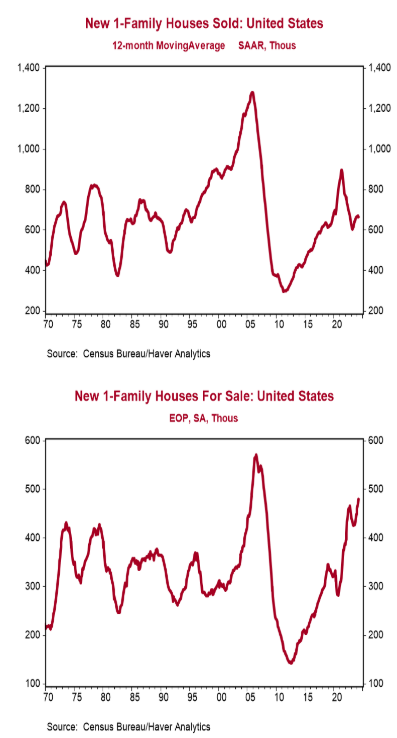- New single-family home sales declined 4.7% in April to a 0.634 million annual rate, lagging the consensus expected 0.678 million. Sales are down 7.7% from a year ago.
- Sales in April fell in the Northeast, West, and South, but rose in the Midwest.
- The months’ supply of new homes (how long it would take to sell all the homes in inventory) rose to 9.1 in April. The gain was due to both the slower pace of sales and a 10,000 unit increase in inventories.
- The median price of new homes sold was $433,500 in April, up 3.9% from a year ago. The average price of new homes sold was $505,700, up 1.0% versus last year.
Implications: There wasn’t much to get excited about in today’s report on new home sales, which fell 4.7% in April. It looks like activity is stuck in low gear, with sales having normalized roughly at the same pace they were in 2019 before COVID. Stubbornly high inflation continues to be the biggest headwind to a broader recovery, with 30-year fixed mortgage rates remaining above 7%. Assuming a 20% down payment, the rise in mortgage rates since the Federal Reserve began its current tightening cycle amounts to a 32% increase in monthly payments on a new 30-year mortgage for the median new home. The good news for potential buyers is that the median sales price of new homes has fallen 6% from the peak in 2022. However, it’s important to note that this drop in median prices is likely due to the mix of homes on the market including more lower priced options as developers complete smaller properties. Supply has also put more downward pressure on median prices for new homes than existing homes. The supply of completed single-family homes is up over 200% versus the bottom in 2022. Total inventories have continued to climb higher as well, hitting a new post pandemic high in April. This contrasts with the market for existing homes which continues to struggle with an inventory problem, often due to the difficulty of convincing current homeowners to give up the low fixed-rate mortgages they locked-in during the pandemic. But this does not mean that housing is getting more affordable per square foot, with the Census Bureau reporting median prices on this basis up 45% from 2019 to 2022, the most recent data available. Though not a recipe for a significant rebound, more inventories giving potential buyers a wider array of options will continue to put a floor under new home sales. One problem with assessing housing activity is that the Federal Reserve held interest rates artificially low for more than a decade, and buyers started to believe those low rates were normal. With rates now reflecting true economic fundamentals, the sticker shock on mortgage rates for potential buyers is very real. However, we have had strong housing markets with rates at current levels in the past, and as long as the job market remains strong and buyers understand that the past was a mirage, it’s possible they will eventually adjust. In other news this morning, initial claims for jobless benefits fell 8,000 last week at 215,000, while continuing claims rose by 8,000 to 1.786 million. The figures are consistent with continued job gains in May.





